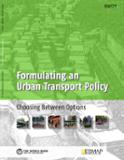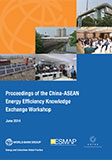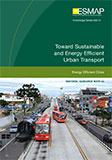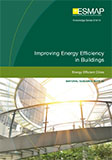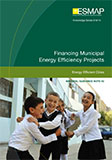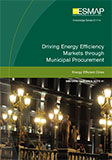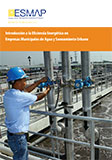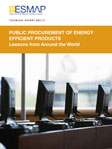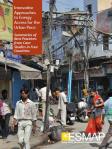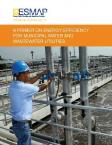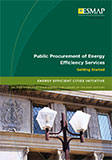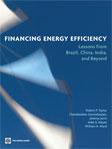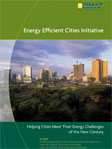| Featured Publications | Urban Energy | Analytical Tools for Municipal EE Planning | Efficient Cities Initiative |
Energy Efficient Cities is working to identify innovative approaches to design and implement energy efficiency programs at the city level. To this end, the program has developed tools, guidance notes, and other products to help cities better understand their energy needs and develop policies and programs to use energy more efficiently. A summary of these is found below.
Formulating an Urban Transport Policy: Choosing between Options
This document policy lays out the guiding principles for more detailed downstream planning. The objective of this guideline is to improve mobility, environmental quality, universal access, safety, and energy security of any urban transport policy. This guidebook is intended to be a practical support for formulating urban transport policies at the national, provincial, and local levels.
Proceedings of the China-ASEAN Energy Efficiency Knowledge Exchange Workshop
The workshop was designed to disseminate China’s successful experience in energy efficiency and promote South-South knowledge exchange on energy efficiency between China and other Asian countries.
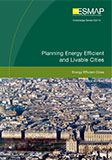
Planning Energy Efficient and Livable Cities | Mayoral Guidance Note #6
This note advises city leaders on how to manage the growth and transformation of urban forms toward an energy efficient and livable path through supportive planning policies, zoning regulations, and design guidelines.
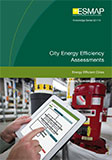
City Energy Efficiency Assessments | Mayoral Guidance Note #5
This guidance note provides an introduction to the objectives, scope, and outputs, as well as the basic steps and approaches of conducting the three types of energy efficiency assessments. It may be used as a general reference for choosing and defining the type of energy efficiency assessment that a city might pursue.
Toward Sustainable and Energy Efficient Urban Transport | Mayoral Guidance Note #4
The objective of this guidance note is to present a systematic, practical, and comprehensive approach to dealing with the problems of urban transport. It outlines a framework of possible interventions and demonstrates how such interventions relate to the overall objectives of improving mobility and energy efficiency as well as reducing air pollution and road accidents.
Improving Energy Efficiency in Buildings | Mayoral Guidance Note #3
This guidance note outlines how cities can tap into a wide array of proven technologies, policies, and financing mechanisms to improve energy efficiency and capture cost-effective energy savings in buildings. It offers city leaders advice on how to get started in introducing energy efficiency measures, and provides lessons and examples from successful programs that have been introduced worldwide.
Financing Municipal Energy Efficiency Projects | Mayoral Guidance Note #2
This guidance note focuses on how municipalities can access financing for energy efficiency investments, particularly for projects in the following four areas: (i) indoor lighting; (ii) building retrofits: (iii) public lighting; and (iv) municipal utilities.
Driving Energy Efficiency Markets through Municipal Procurement | Mayoral Guidance Note #1
This guidance note outlines the opportunities and barriers to adopting these procurement strategies, provides global lessons and examples, and offers step-by-step guidance on how cities can get started with energy efficient purchasing policies.
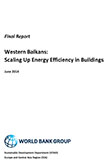
Western Balkans | Scaling Up Energy Efficiency in Buildings
The key findings and results of the project’s first phase, as summarized in this report, were presented in June 2013 at a regional workshop in Vienna at which stakeholder delegations from all six Western Balkan countries were represented.
This report reflects the discussions and feedback received at the conference. It was also circulated and shared with the Energy Community Secretariat, donors, government counterparts, and other stakeholders.
Introducción a la Eficiencia Energética en Empresas Municipales de Agua y Saneamiento Urbano
Este manual se refiere al uso de la energía y la eficiencia energética en la red de distribución de agua y tratamiento de aguas residuales en las zonas urbanas. Se centra en el lado de la oferta del ciclo del agua municipal, incluyendo la extracción, tratamiento y distribución de agua, así como la recolección y tratamiento de las aguas residuales -actividades que son directamente gestionadas por las empresas municipales de agua y saneamiento urbano (EMASU).
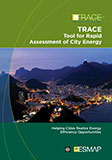
TRACE | Tool for Rapid for the Assessment of City Energy: Helping Cities Use Energy Efficiently
The Tool for Rapid Assessment of City Energy (TRACE) is a decision-support system designed to help cities quickly identify and harness EE opportunities. It targets underperforming sectors, evaluates improvement and cost-saving potential, and helps prioritize actions for EE interventions. TRACE focuses on the municipal sectors with the highest energy use: passenger transport, municipal buildings, water and wastewater, public lighting, power and heat, and solid waste.
Rapid urban growth in developing countries has created an unprecedented demand for energy services. Cities face the enormous challenge of improving energy access to urban communities in order to improve education, health and basic socioeconomic conditions. These eight case studies demonstrate innovative, successful approaches to delivery of energy services to the urban and peri-urban poor. The case studies focus on electricity and clean fuels, and are taken from India, Brazil, Colombia and Bangladesh.
Improving energy efficiency is at the core of measures to reduce operational cost at water and wastewater utilities. Since energy represents the largest controllable operational expenditure of most WWUs, and many EE measures have a payback period of less than five years, investing in efficiency supports quicker and greater expansion of clean water access for the poor by making the system cheaper to operate.
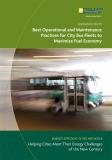 Best Operational and Maintenance Practices for City Bus Fleets to Maximize Fuel Economy
Best Operational and Maintenance Practices for City Bus Fleets to Maximize Fuel Economy
Many cities are dominated by often old and fuel-intensive buses with high operating costs. This guidance note provides detailed and practical recommendations on how city bus operations managers and their technical staff can plan and implement enhancements to their fleets through operational and maintenance practices without significant capital investments.
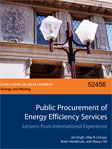 Public Procurement of Energy Efficiency Services: Lessons from International Experiences
Public Procurement of Energy Efficiency Services: Lessons from International Experiences
This study looks at a largely untapped energy efficiency market, the public sector. While the efficiency potential in this sector is substantial, the implementation of energy savings programs has been complicated by a number of factors, such as insufficient incentives to lower energy costs, rigid budgeting and procurement procedures, and limited access to financing. Learn more.
Public Procurement of Energy Efficiency Services | Getting Started
This note offers operational guidance on how to get started with energy efficiency services procurement programs. It starts with a summary of the main findings of the ESMAP publication: Public Procurement of Energy Efficiency Services: Lessons from International Experiences and then delves into the modalities of operationalizing these findings for World Bank (WB) operations, including issues of WB procurement and financing.
Rather than seek to recommend changes in WB procedures, it presents some ideas and options under current WB processes to formulate operational approaches and strategies to deliver large-scale energy savings to public agencies, at both the national and local levels.
Energy Efficient Cities: Assessment Tools and Benchmarking Practices
Energy Efficient Cities: Assessment Tools and Benchmarking Practices is an effort to catalyze solutions that would delink high levels of carbon-intensive energy use from Energy Efficient Cities: Assessment Tools and Benchmarking Practices is an effort to catalyze solutions that would delink high levels of carbon-intensive energy use from urban growth. It has been developed from a careful review of selected papers presented during two ESMAP-sponsored sessions at the Fifth World Bank Urban Research Symposium, “Cities and Climate Change: Responding to an Urgent Agenda. Learn more.
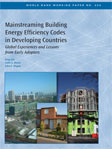 Mainstreaming Building Energy Efficiency Codes in Developing Countries: Global Experiences and Lessons from Early Adopters
Mainstreaming Building Energy Efficiency Codes in Developing Countries: Global Experiences and Lessons from Early Adopters
Building energy efficiency codes (BEECs), which regulate the energy performance of building design and its compliance during construction, are broadly recognized as a necessary government intervention to capture the economic potential of energy efficiency gains in residential, commercial, and public service buildings. Mainstreaming Building Energy Efficiency Codes in Developing Countries aims to inform both World Bank Group and its clients about global best practices and emerging lessons from developing countries in design and implementation of BEECs. Access overview. Purchase this publication. (Geographic discounts available).
Financing Energy Efficiency: Lessons from Brazil, China, India, and Beyond
Greater energy efficiency is key for shifting country development paths toward lower-carbon economic growth. Especially in developing countries and transition economies, vast potential for energy savings opportunities remain unrealized even though current financial returns are strong. This volume examines the nature of this dilemma and how it may be overcome in practical and operational terms.
Energy Efficient Cities Case Studies Database
Energy Efficient Cities Case Studies Database is home to several dozen urban energy efficiency case studies across all sectors—transport, buildings, lighting, water, solid waste, heating/power—in both developing and developed countries.
ESMAP's Energy Efficient Cities
Cities are an important engine for economic growth and socioeconomic development. By 2030, almost 5 billion (about 60 percent of the global population) will live in cities, leading to massive requirements for energy to power growth and expand basic infrastructure. Energy efficiency can offer practical solutions to budget-constrained cities to meet their energy needs without sacrificing their development priorities. This is because energy efficient activities are generally cost-effective; that is, higher upfront investment for a more efficient system is offset by lower recurring energy costs. In October 2008, ESMAP launched the five-year Energy Efficient Cities Program to promote energy-efficient programs and planning among cities in developing countries.
More information | Download the brochure
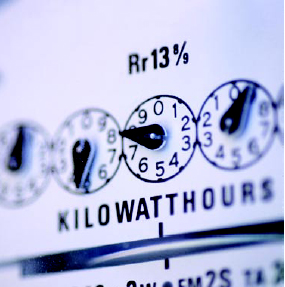
Energy Efficiency Indicators: Best Practices and Potential Use in Developing Country Policy Making
Energy efficiency indicators are widely considered an important tool to support energy efficiency policy making. Although substantial international efforts have been made to develop indicators and to draw lessons from national and international trends and comparative analyses, in developing countries, a lack of data currently limits the role energy efficiency indicators can play. International organizations and development agencies can support this effort through financial and technical support, dissemination of information and tools, and by incorporating the development and application of energy efficiency indicators in their core strategic and funding activities. Communication Note | Report
Resources
Contact: Ivan Jaques, Energy Efficient Cities Program Team Leader, ESMAP
ESMAP | Energy Efficient Cities | Achievements | News | Blogs | Events | Publications
